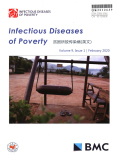- 钛学术文献服务平台 \
- 学术期刊 \
- 医药卫生期刊 \
- 内科学期刊 \
- 贫困所致传染病(英文)期刊 \
Cutaneous leishmaniasis control in Alta Verapaz (northern Guatemala): evaluating current efforts through stakeholders’ experiences
Cutaneous leishmaniasis control in Alta Verapaz (northern Guatemala): evaluating current efforts through stakeholders’ experiences
基本信息来源于合作网站,原文需代理用户跳转至来源网站获取
摘要:
Background::Cutaneous leishmaniasis (CL), endemic in Guatemala, mostly affects poor people living in the northern region. A national control program that includes surveillance, diagnose, and treatment offered free of cost by the Ministry of Health (MoH) has been in place since 2003. However, the incidence is increasing and treatment rates are not optimal, suggesting that current efforts are not being effective. This study aimed to understand barriers and facilitators of CL control in Guatemala as experienced and perceived by key stakeholders in order to comprehend what works well and does not and suggest evidence-informed interventions.Methods::The study was conducted in the Cobán municipality, the most endemic of Guatemala, situated in the Department of Alta Verapaz. Data were collected during May and June 2019 via focus groups and semi-structured interviews with key stakeholders, including local and national health personnel and residents of four communities of the endemic region. Thematic and content analysis of the collected data was conducted using NVIVO.Results::Three overarching issues hamper the effectiveness of current CL efforts: resource scarcity, treatment challenges, and knowledge-action gaps. Scarce economic resources from the MoH and community residents negatively impact incidence, detection of cases and treatment rates in that preventive action is insufficient and healthcare access is low. In addition, local health workers often lack specialized CL training and access to the national CL control guidelines. With regards to the population living in the study area, misunderstanding of disease causation, shame associated with CL lesions, treatment pain fear, and long (often uncertain) waiting times for diagnose and treatment negatively affect people’s willingness to seek help, treatment adherence, and their trust on the healthcare provided.Conclusions::Culturally sensitive CL preventive action must be developed. Given the scarce economic resources available for CL control in the country, the involvement of trained community health workers and the inclusion of thermotherapy as a treatment option is also advised. Other cost-effective actions include: ensuring all health workers receive CL training and have access to national CL control guidelines, improving national procurement system to avoid treatment shortages, and provision of motorized vehicles to increase active surveillance and treatment rates.

推荐文章
Virasoro-Current代数的形式变形
Hom-Lie代数
Virasoro-Current代数
形式变形
Coolmax(R) Alta纬编弹性针织物的染整工艺探讨
染整工艺
纬编织物
芯吸性
弹性纤维
基于Control Build软件的热轧单机架仿真
热轧
轧机
Control Build
仿真
关于钒电池中支路电流(shunt current)的计算
钒电池
支路电流
内容分析
关键词云
关键词热度
相关文献总数
(/次)
(/年)
文献信息
| 篇名 | Cutaneous leishmaniasis control in Alta Verapaz (northern Guatemala): evaluating current efforts through stakeholders’ experiences | ||
| 来源期刊 | 贫困所致传染病(英文) | 学科 | |
| 关键词 | Cutaneous leishmaniasis Control effort Qualitative evaluation Stakeholders’ experiences Alta Verapaz Guatemala | ||
| 年,卷(期) | 2021,(3) | 所属期刊栏目 | Research Article |
| 研究方向 | 页码范围 | 14-25 | |
| 页数 | 12页 | 分类号 | |
| 字数 | 语种 | 中文 | |
| DOI | 10.1186/s40249-021-00842-3 | ||
五维指标
引文网络
引文网络
二级参考文献 (0)
共引文献 (0)
参考文献 (16)
节点文献
引证文献 (0)
同被引文献 (0)
二级引证文献 (0)
1990(2)
- 参考文献(2)
- 二级参考文献(0)
1992(1)
- 参考文献(1)
- 二级参考文献(0)
2007(1)
- 参考文献(1)
- 二级参考文献(0)
2009(1)
- 参考文献(1)
- 二级参考文献(0)
2014(2)
- 参考文献(2)
- 二级参考文献(0)
2015(1)
- 参考文献(1)
- 二级参考文献(0)
2016(2)
- 参考文献(2)
- 二级参考文献(0)
2018(4)
- 参考文献(4)
- 二级参考文献(0)
2020(2)
- 参考文献(2)
- 二级参考文献(0)
2021(0)
- 参考文献(0)
- 二级参考文献(0)
- 引证文献(0)
- 二级引证文献(0)
研究主题发展历程
节点文献
Cutaneous leishmaniasis
Control effort
Qualitative evaluation
Stakeholders’ experiences
Alta Verapaz
Guatemala
研究起点
研究来源
研究分支
研究去脉
引文网络交叉学科
相关学者/机构
期刊影响力
贫困所致传染病(英文)
主办单位:
中华医学会
出版周期:
双月刊
ISSN:
2095-5162
CN:
10-1399/R
开本:
出版地:
上海市黄浦区瑞金二路207号
邮发代号:
创刊时间:
2016
语种:
eng
出版文献量(篇)
434
总下载数(次)
0
总被引数(次)
45
期刊文献
相关文献
推荐文献
- 期刊分类
- 期刊(年)
- 期刊(期)
- 期刊推荐

 免费查重
免费查重










